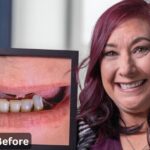Do you or your kids have dental sealants protecting those back molars from decay? If so, you may be wondering how long the sensitivity and slight discomfort can last after getting these thin plastic coatings applied to your teeth. Many people report dental sealants feeling a bit abnormal for the first day or two before adjusting to the smooth protective layers shielding their tooth enamel.
This article on dental sealants will explain everything you need to know. We’ll explore what sealants are, and why they’re so important, walk through the quick and painless sealing procedure, and most importantly, provide timelines for how long it takes sealants to feel normal again.
What Are Dental Sealants?
Dental sealants are thin, plastic coatings that dentists apply to the pits and grooves of chewing surfaces of primary molars. These sealants act as a barrier between teeth and plaque (a film of bacteria and food debris on teeth). This protects vulnerable areas that are hard to reach with a toothbrush from decay and cavities.
Purpose of Dental Sealants
- Prevent tooth decay
- Shield teeth from plaque and bacteria
- Stop cavities from forming on vulnerable tooth surfaces
- Often last 5 to 10 years with proper dental care
- Without dental sealants, the deep grooves on molars are difficult to keep clean and at high risk for unchecked decay. It can lead to expensive dental fillings or other treatments. Sealants provide an extra layer of long-term prevention.
Why Are Dental Sealants So Important?

The Centers for Disease Control and Prevention report that over 90% of American adults aged 20-64 have had cavities in their permanent teeth. As we age, our tooth enamel can wear down from exposure to acidic foods and plaque bacteria. This erosion makes teeth more vulnerable to decay.
Dental sealants are important because they:
Prevent decay: Sealants stop bacteria from gathering in rough tooth surfaces and lower decay risk by nearly 80% in 2–5 years.
Reduce costs: Getting sealants put on costs a third less than getting a single filling. Preventing cavities with sealants avoids much pricier dental work down the road.
Protect children’s teeth: Getting sealants soon after molars emerge (around ages 6 and 12) allows your dentist to protect teeth before heavy exposure to plaque bacteria causes decay.
The Dental Sealant Procedure

The process of getting sealants applied is quick, easy, and painless, taking just a few minutes per tooth once the surface is prepared.
Here is a step-by-step overview:
The tooth surface is cleaned thoroughly and dried with cotton rolls and an air jet.
An adhering gel (a mild etching acid) is applied to roughen the enamel surface so the sealant can bond tightly to your tooth. This gel is rinsed off after about 20 seconds.
After ensuring the area is dry, your dentist applies the liquid dental sealant, which flows into the grooves of your molar filling in any hollows.
A curing light is used to harden the sealant, securing it to your tooth surface. This protective plastic coating layers your tooth and seals vulnerable spots off from your mouth and plaque.
Your bite is checked to ensure the sealant layer is smoothed down properly so you can chew comfortably with no high spots.
The sealing process from start to finish takes just a couple of minutes per tooth, and the curing light and other steps are completely painless and cause no discomfort.
What are dental sealants made of?
There are a few types of materials used to create the protective sealant layers applied by dentists:
Plastic resins like acrylic resins and bisphenol A glycidyl methacrylate (bis-GMA) are commonly used as they bond well to enamel.
Glass ionomer cements act as dental sealants but also release fluoride to further protect teeth.
These plastic and resin dental products are non-toxic, safe for long-term use, and ideal for shielding teeth from bacteria and plaque acids. The materials can withstand years of chewing forces without fracturing or wearing down.
Do Dental Sealants Hurt?

For most people, sealants cause no pain whatsoever during or after the quick sealing procedure. The preparatory tooth cleaning, etching gel, rinsing, and curing light cause no pain or discomfort. Numbing gel can be used if you experience any sensitivity.
You may notice a slight difference in texture on the treated teeth when running your tongue over them or eating following the procedure. The plastic coatings may feel slightly rough or raised initially.
It’s common to have some temperature sensitivity when consuming very hot or cold foods for the first 24-48 hours after sealant placement. This is temporary and resolves quickly as your mouth adjusts.
Over-the-counter pain medication can provide relief if you experience any tenderness when chewing or minor throbbing following your appointment. Discomfort typically lasts no more than a couple of days.
Benefits of dental sealants
Along with the preventative dental perks already covered, sealants offer a few key benefits:
They are easy and painless for dentists to apply, unlike dental fillings which require numbing and drilling into teeth. Getting sealants is very cost-effective compared to future resin or amalgam fillings down the road. The plastic coatings help strengthen your tooth structure.
Bacteria have a harder time sticking to the smooth sealant surface. Most sealants provide effective protection from decay for 5-10 years, though regular dental checkups are still essential. Reapplication may eventually be needed as sealants can wear down over time from chewing forces. For kids and adults prone to cavities or with hard-to-brush molars, sealants are an invaluable tool in the prevention of tooth decay.
How Long Does Dental Sealants Take to Feel Normal?

While getting dental sealants causes no actual pain, you’ll likely notice a bit of a strange sensation at first after having the procedure done as the tooth surfaces will feel different. The good news is sensitivity and tenderness are typically temporary. Here’s a general timeline for when sealed teeth should feel normal again:
Immediately after
Sealants may feel a little bulky, irregular, or grainy from the textured plastic now overlaying parts of your molars. Your tongue will notice the difference right away.
1-2 days later
Any temperature or chewing sensitivity peaks during this time frame as your nerves adjust to the new barrier on your molars. Mild throbbing is possible.
3 days later
Sensitivity to hot and cold diminishes greatly. Molars start feeling less abnormal.
5-7 days later
You should adjust to the texture changes from sealants. There may still be slightly raised or smooth spots but no more pain.
1-2 weeks later
Teeth with sealants generally feel normal again in terms of texture and temperature sensitivity fading completely.
Proper oral care like regular brushing and flossing around sealants helps minimize discomfort. Using a soft-bristle toothbrush and being gentle initially can further prevent tenderness while your mouth adjusts. Avoid hard, crunchy, or sticky foods that could disrupt freshly applied sealants.
Within about two weeks, you shouldn’t notice the sealants at all in your everyday life. But these thin preventative layers will keep protecting your molars year after year. Getting checkups every 6 months ensures your dentist can assess if any reapplication is needed in the future.
FAQ’s
How long do dental sealants last?
Dental sealants typically last for around 5-8 years if applied properly. They form a protective barrier on the chewing surfaces of teeth. Regular dental checkups can help monitor their condition and determine if dentures need replacing.
What can you use to repair dentures?
Some common products used to repair dentures include denture adhesive, denture recliner or soft liner, and denture repair material. Adhesives help keep dentures in place while reliners and repair materials can fix cracks or reline ill-fitting dentures for a better fit. Dentists can also repair or reline dentures professionally.
Are dental sealants safe?
Yes, dental sealants are considered very safe when placed by a dentist. They are made from materials like resin and don’t damage enamel. Any risks are usually very low and minor like tooth sensitivity occasionally after placement. Overall, sealants pose minimal health risks and are effective at protecting teeth.
Do dental sealants hurt?
Getting dental sealants applied may involve some minor discomfort but usually does not cause severe pain. Any pain felt is mild and brief, often compared to pressure. Dentists use local anesthesia to numb the area being sealed to minimize discomfort. Children commonly feel little to no pain from the quick sealing process.
Are there any risks associated with dental sealants?
While very safe, rare potential risks from dental sealants include tooth sensitivity after placement and small cracks forming in the enamel. Otherwise, there is little risk to dental health with sealants when done by a professional in a proper clinical setting. Any minor procedure has a small element of risk but sealants are highly beneficial for preventing cavities with minimal downsides.
Conclusion
Adjusting to the feel of dental sealants is usually only temporary. Any slight roughness or sensitivity resolves within about two weeks at most, while you continue to benefit from their decay protection for years to come. As the plastic coatings prevent the need for dental fillings and treatment down the road, a little initial tenderness is well worth it.
Sealing vulnerable tooth surfaces is a fast, pain-free way to shield teeth from harmful plaque acids and bacteria. While sealants may feel slightly abnormal at first, soon you won’t even notice them working hard to prevent cavities and decay.











